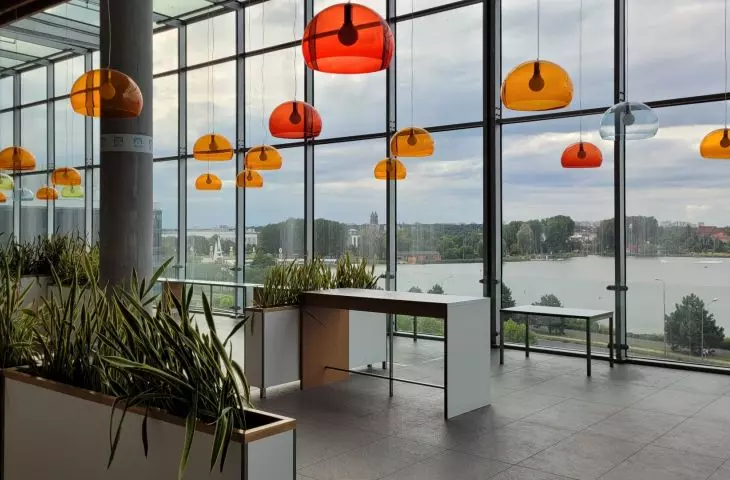The demolition of the architecture of the last thirty years has reached Poznan as well. Not only is the post-modern Multikino in the city center to be demolished, but also the newer shopping center by Lake Malta. The worn-out multiplex is a quarter of a century old. The mall is only 14 years old. There are other buildings waiting in line for the bulldozer.
Significant buildings from the 1990s are going under the pick in many Polish cities. Despite protests in Wroclaw, the famous Solpol (designed by Wojciech Jarząbek) was demolished. In Warsaw, the Atrium International complex (design: Biuro Kazimierski i Ryba, 1995) disappeared this year—also not without controversy, although weaker than in the case of Wroclaw. In Poznań it will go rather without protests. The 1998 Multikino building (full name: Multikino 51) is to be demolished. As the local Gazeta Wyborcza recently reported, an application for demolition was submitted to the City Hall by the NP16 company ( Nexity Group).
Multikino 51 on Królowej Jadwigi Street in Poznań.
photo: Jakub Głaz
sentiment and location
The facility may have sentimental value for some; it was the first multiplex of its kind in the country (8 auditoriums, with a total of over 2,000 seats). However, there is no question of architectural value here, as was the case with the controversial, but nevertheless thoughtfully designed Solpol. Nor is it, like the capital's Atrium, a building that creates a typically urban fabric. The utilitarian, simple body is decorated only at the front with a curved curtain façade. The building is embellished with typical 90s details in the form of grates, masts and arched canopies. The windowless elevations and ample parking at the rear are more befitting of a suburban shopping and entertainment complex.
The western elevation of Multikino 51 with its distinctive canopy over the side entrance
photo: Jakub Głaz
What is important instead is the location, the importance of which has grown enormously over the past quarter century. The multiplex is located in a very attractive spot in the center today, next to the intersection of Królowej Jadwigi Street with Półwiejska and Górna Wilda Streets, at the edge of the so-called southern wedge of greenery cutting into the city along the Warta River. When it was built, the famous Old Brewery in its present form (after expansion and conversion to commercial and cultural purposes in 2003-2007, designed by Studio ADS) was not yet standing in close pro ximity. At that time, the plans also still included office skyscrapers, which were built on Anders Square between the cinema and the Brewery (the construction of the last of the skyscrapers and the tallest in the city is currently underway: Andersia Silver, proj. of the entire complex: Ewa and Stanislaw Sipinski Architectural Studio).
parking lot at the back of the Multikino, southern elevation visible; on the left, Andersia skyscraper complex, Andersia Silver under construction
photo: Jakub Głaz
accent by the stadium
Finally, between the cinema and the very distinctive, low, long AWF building on Królowej Jadwigi Street (design: Marek Leykam, construction: 1973) stood the Marathon office complex (design: CDF Architects) in 2016, with a scale exceeding the dimensions of both neighbors. Earlier, a small and dense complex of multifamily houses was built behind it. There were also temptations by private investors to carve out more parts of the green wedge for housing, retail and services, including the ruined Szyc Stadium. Luckily, this was prevented, and the stadium and its surroundings are to be used primarily for leisure and recreation. A study competition for the concept of developing the area was settled this year.
Królowej Jadwigi Street; view from the west: Multikino 51, Maraton office buildings
photo: Jakub Głaz
What will be built instead of the Multikino? There are no concrete announcements or, much less, visualizations yet. However, there is a local plan, which allows for the erection of a commercial or residential building, or one with a mixed function, on the plot after the Multikino. Height: up to 30 meters, flat roof, maximum number of floors: six, with the last floor having to be set back by at least 0.6 meters. The maximum building area is 30 percent of the site, and the biologically active area must occupy 50 percent of the plot (including half of the area of a possible green roof). So there is a chance that an interesting accent will be created here, ending the southern frontage of this section of the street. It will be good if it reaches the high quality of the corner plat that completed the opposite frontage in 2015 (designed by Easst Architects).
The green connector between Królowej Jadwigi Street and the area next to Szyc Stadium; Multikino 51 on the left behind the frame
photo: Jakub Głaz
commercial cannibalism
Coincidence has it that a multiplex of the same chain also operates in the Galeria Malta shopping center on Baraniaka Street by Lake Malta (designed by Ewa and Stanislaw Sipinski Architectural Studio / APA Wojciechowski, 2009). It too may be demolished, although it too is both younger and much more architecturally successful than the building on Królowej Jadwigi Street. The sizable center has now died down and is almost completely deserted (the exceptions are a movie theater, a private clinic, individual services and stores, and an extensive parking lot).
The northern elevation of CH Malta, view from the lake shore
photo: Jakub Głaz
Malta has been "chanibalized" by Posnania, the city's largest shopping mall (design: BEG INGENIERIE, 2016), built half a kilometer away! This absurd neighborhood is the result of the City's decision 20 years ago to allow big-box retail near Lake Malta, on the site of a former military base.
Posnania shopping center, entrance and square from Kórnicka Street
photo: Jakub Głaz
The permission for commerce next to the lake was granted even though the neighboring site, where rival Posnania stood in 2015, had already been reserved for a shopping and service center since the 1970s. Previous city authorities, however, saw no problem with this. One official even said that there would be a „synergy” between the galleries: people were supposed to stroll between them and revitalize the surrounding streets.
An empty shopping alley of CH Malta
photo: Jakub Głaz
Synergy has not occurred, which is not surprising. The length of all of CH Posnania's alleys is similar to the length of the main downtown streets that once served commercial functions. The mall is also very well connected, lying between downtown and the residential neighborhood of Rataje. Posnania, therefore, has killed not only Malta, but also downtown commerce. The pandemic and e-commerce also did their part. Hence, Malta's current owner applied in May for permission to demolish the building and cut down the surrounding trees and shrubs.
The parking lot of CH Malta and neighboring residential buildings, view from the west
photo: Jakub Głaz
Plans for the site are not yet known, but almost everything indicates that a residential development will be built here. The current local plan does not, admittedly, provide for such a function (currently, retail above 2,000 sq. m. is allowed here), but the study, amended in July, allows the plan to be changed. The study now includes services and multi-family housing.
Office complex and residential buildings on Baraniaka and Lwowska streets on the south side of CH Malta
photo: Jakub Głaz
now tinkerers!
The case of Malta is intriguing, because—after Stary Browar—it is the most successful shopping mall building in the city. The simple, proportional and unpretentious form is timeless. The bright interiors, devoid of glitz, are well lit by daylight, and from the second floor, through a glass wall measuring 850 sq. m., one can view Lake Malta and the city skyline.
The deserted food court of CH Malta
photo: Jakub Głaz
Also of great value is the suspended footbridge over busy Baraniaka Street, built together with the gallery, leading to the promenade around the lake (there are no plans to demolish it). So it would be interesting to rebuild CH Malta, although it would then serve more as an office building (this is what happened to Poznan's first shopping mall Victoria Center on Garbary Street). Adapting the massive and windowless reinforced concrete block into a residential building seems a breakneck venture. The location by the lake, next to the Polytechnic campus, near the Warta River and on the outskirts of the city center is so attractive that it will probably pay off for the investor to both demolish and build everything from scratch.
The northern elevation of the Malta Shopping Center as seen from under the footbridge pylon
photo: Jakub Głaz
This is, by the way, the beginning of a series of demolitions of shopping centers in Poznań, but these are the so-called „first-generation ” buildings older than Malta (customarily known as "tinsel"). Two years ago we described the intentions for the decommissioned TESCO complex in the Piątkowo district. Another facility, which belonged to the same company, stands almost empty in Winogrady. Together with the parking lot, it occupies the area of a medium-sized housing estate. The new study in both cases allows apartments to be built, and this will probably happen. Both locations are ideally suited for this, and no one will cry after the disastrously located 1990s markets.


















































































